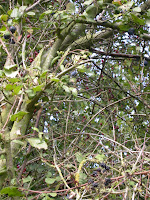Christmas cards
Use coloured card, and decorate with pictures from magazines or old Christmas cards, glitter and gel pens.
Gingerbread cookies
Use the recipe at the end of this post to make the biscuits, then decorate with icing and sweeties
Decorated candles
Glue ivy leaves, cloves, lace, sequins, pressed flowers, dried fruit and cinnamon sticks round the candles.
Place markers for the dinner table
Cut rectangles from card and decorate the same as for the cards
Wreath for the front door
Wreaths can be as simple or as difficult as you want. Bend an old coathanger into shape and tie on bits of greenery and small tree decorations. Finish with a big red bow or a tartan ribbon.
Christmas cake
Make a cake from scratch, or decorate a shop-bought one. Stick on decorations with blobs of icing, or draw a Christmas scene with icing pens. Colour-in a wide paper border and use a pin to secure it round the cake.
Dough-craft decorations for the tree
2 cups plain flour, 1 cup salt, .75 cup water, 10ml cooking oil. Use cookie cutters to make shapes, and bake at 80ºC (175º) overnight or microwave on LOW for 10 seconds at a time until dry. Paint and varnish.
Peppermint Creams
One egg white, 250g icing sugar and a few drops of peppermint essence – yummy!
Mulled wine spices in muslin
Mix cloves, cinnamon, nutmeg and sugar in a bowl. Tie in pieces of muslin or pour into tiny jars. Give as presents.
‘Snowy’ fir cones for the tree
Paint fir cone tips with white paint and glitter.
Country-style gingham hearts
Use red or green fabric to make tiny hearts. Stuff with off-cuts of material or bits of wool. Add a hanging loop and a bow. Use gingham and string for a country look.
Table decorations
Melt the bottom of a candle, and stick it onto a plate or bowl, or use plasticine to keep it secure. Pile oranges, lemons, ivy, holly, nuts and fir cones round the edge. Spray some of the nuts or fruit gold for a really special effect, and add some tiny bits of tinsel.
Use salt dough to make candle holders
Candle holders from fir cones or dough
Use the dough recipe and model tiny fir cones and leaves. Bake as before. Or cut a circle of card and glue cones, leaves, tiny presents etc round. Use red and green for a traditional look, or purple and silver for modern madness!
Advent calendar
A hanging with pockets, a pile of tiny presents, envelopes to open – all make great advent calendars.
Chocolate truffles
225g digestive biscuits(crushed), 115g butter, 1 large tin condensed milk, 4 tablespoons coconut, 4 tablespoons cocoa powder. Melt the butter, and add the other ingredients. Cool. Shape into balls, and roll in coconut, cocoa, chocolate vermicelli or nuts
Tiny fabric stockings for the tree
Use Christmas fabric if you can find it, or bright red material. Cut out stocking shapes, add a white lacy top, and sew on a hanging loop of red ribbon. If you’ve made it big enough, it will hold a tube of Smarties!
Marzipan fruits for presents
Shape coloured marzipan into fruit shapes and paint with food colouring. Use cloves for stalks. Decorate gift boxes and give as presents.
Christmas puddings
Advanced cooking for the adventurous! Microwave recipes will get the job done in half the time. Don’t add traditional silver coins in case someone chokes.
Painted glass tea-light holders
Use tiny glass jars and paint with glass paints. Draw your design on paper and hold it behind the glass, and trace over it. – simple!
Gingerbread house
Use the gingerbread recipe to make a house. Decorate with icing snow and lots of sweets!
Printed wrapping paper
Use plain brown wrapping paper or jewel coloured tissue. Cut a design from a potato, print leaves, or just use gold/silver gel pens and draw a repeat design on. Little swirls or stars repeated all over look great – or write your own special Christmas message.
Collaged and printed gift tags
Use a template to cut out gift tags from thin card. Glue on pictures from magazines, bits of holly, ivy leaves, gold foil, pieces from old Christmas cards etc. Add a piece of hairy garden twine or some embroidery thread to attach it to the present.
Menu for the dinner table
Use your computer to print out the Christmas Day menu, then decorate with glitter and glue.
Knitted Christmas stocking
Look on the internet for a pattern, or go through Granny’s workbooks. No patience for knitting? Sew a huge stocking shape and appliqué Christmas shapes. Don’t forget to add your own name so Santa leaves the right presents.
Painted Christmas plates, bowls and glasses
Use plain white crockery, and paint with ceramic paints from craft shops. Bake in the oven to harden, and use to serve Christmas snacks. Use glass paint outliner tubes to draw onto little bowls for nuts and nibbles.
Gingerbread Recipe
340 g plain flour
1 teaspoon ground cinnamon
1 teaspoon ground ginger
1 teaspoon bicarbonate of soda
85g brown sugar
pinch of ground cloves
115g butter
1 egg
4 tablespoons clear honey
Grease a baking sheet, and set the oven to 190ºC. Melt the butter, sugar and honey together. Beat the egg. Sift the dry ingredients together. Mix everything together, and leave for 30 minutes. Roll out, and cut into shapes. Poke holes in the tops for the hanging ribbon to go through.Bake for 15 minutes. Decorate. Hang up with very narrow red ribbon.
This contains lots of ideas – search the internet or in books for more ideas, and detailed instructions.





+front+only.jpg)







































